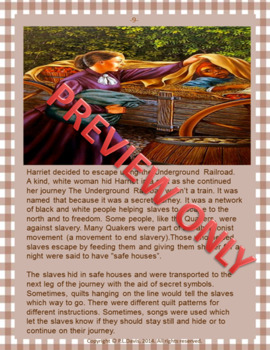

Runaway! Fugitive Slave Ads in Newspapers, a Headlines and Heroes blog.These newspaper accounts offer us valuable glimpses into the extraordinary heroism of Harriet Tubman, as well as providing examples of the wealth of primary sources available in Chronicling America.* The article, “ Troubles of a Heroine,” which Taylor wrote just prior to his book’s publication, requested that checks be sent directly to Tubman for the payment of the mortgage of her property so that she could turn it into an “Old Folk’s Home.” Twelve years later, on March 10, 1913, Tubman died at the Harriet Tubman Home for Aged Negroes, Auburn, New York. These books provided some financial relief to a nearly destitute Tubman. Taylor, financial secretary, Tuskegee Institute. Bradford, and Harriet Tubman, the Heroine in Ebony (1901), by Robert W. Certain content in these profiles may have been embellished at times, in keeping with such contemporary biographies as Scenes in the Life of Harriet Tubman (1869) and Harriet, the Moses of her People (1886), both by Sarah H. This and several other later articles are featured in Harriet Tubman: Topics in Chronicling America, recounting her Underground Railroad days, her impressive Civil War service as a nurse, scout, and spy in the Union Army, and her post-war efforts.

The lengthy 1907 article that accompanied the illustration in The San Francisco Call, focused on Tubman’s lifelong commitment to gaining black freedom and equality. “Another Trying to Down Her, She Choked into Half Unconsciousness”, The San Francisco Call (San Francisco, CA), September 29, 1907, p. Later coverage of Tubman’s role was often laudatory and dramatic. Antislavery publications at the time applauded Nalle’s rescue, but initially did not mention Tubman by name. When she spoke about these events at the Woman’s Rights Convention in Boston in early June 1860, the Chicago Press and Tribune reporter responded with racist outrage at the audience’s favorable reaction to Tubman’s story of Nalle’s rescue, as well as her recounting of her trips back to the South to bring others to freedom. A large mainly African American crowd freed Nalle twice and Tubman is credited in some accounts with taking the lead in his rescue.

On April 27, 1860, Tubman’s rescue efforts moved from Maryland to New York, with the rescue of Charles Nalle, who had escaped slavery in Culpeper, Virginia, but was arrested in Troy, New York, where Tubman was visiting. She was illiterate so no written copies of her speeches appeared to be available. In addition, Tubman’s speeches, if written about in newspapers, were only described and briefly quoted, rather than printed in full, as other abolitionists’ speeches sometimes were. “Harriett Tupman” in “A Female Conductor of the Underground Railroad,” The Daily Dispatch (Richmond, VA), June 6, 1860, p. Her earliest attempted escape was with two of her brothers, Harry and Ben, as found in an October 1849 “runaway slave” ad, where she is referred to by her early nickname, Minty. Tubman was born Araminta Ross around 1822. Prior to the Civil War, newspaper coverage of her successful missions was not extensive, but what is there serves to document the breadth of her successes in engineering these escapes. She was called “Moses” for her success at navigating routes, along with knowing safe houses and trustworthy people who helped those escaping from slavery to freedom. She then returned there multiple times over the next decade, risking her life to bring others to freedom as a renowned conductor of the Underground Railroad. Harriet Tubman escaped slavery on Maryland’s Eastern Shore in 1849. Collection of the Library of Congress and the Smithsonian National Museum of African American History & Culture.


 0 kommentar(er)
0 kommentar(er)
